steering MITSUBISHI COLT 2008 (in English) Owner's Guide
[x] Cancel search | Manufacturer: MITSUBISHI, Model Year: 2008, Model line: COLT, Model: MITSUBISHI COLT 2008Pages: 450, PDF Size: 14.57 MB
Page 207 of 450
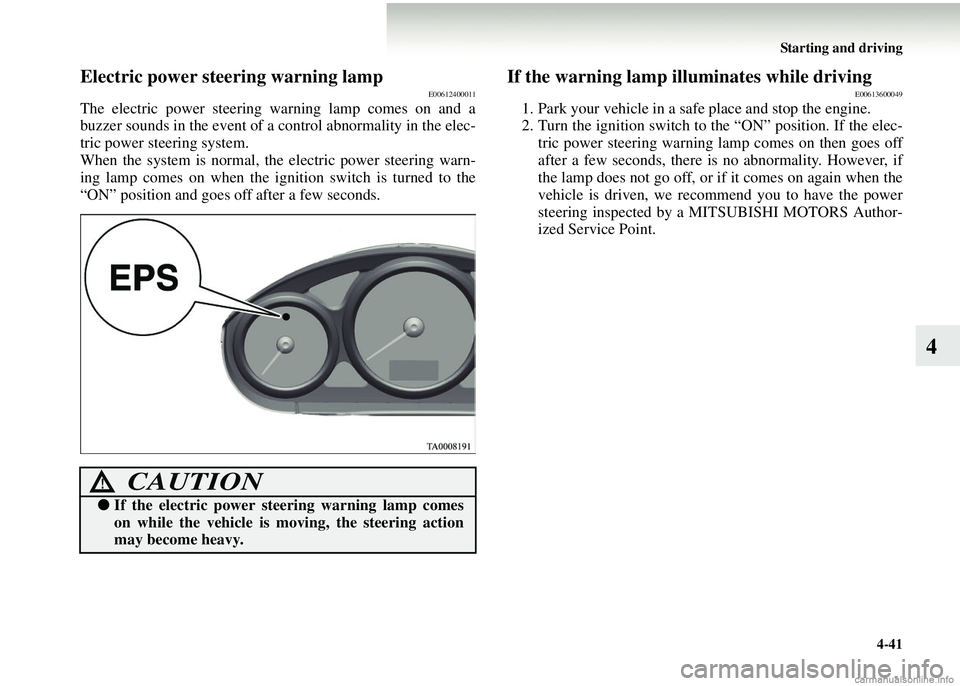
Starting and driving4-41
4
Electric power steering warning lampE00612400011
The electric power steering wa rning lamp comes on and a
buzzer sounds in the event of a control abnormality in the elec-
tric power steering system.
When the system is normal, th e electric power steering warn-
ing lamp comes on when the ignition switch is turned to the
“ON” position and goes off after a few seconds.
If the warning lamp illuminates while drivingE00613600049
1. Park your vehicle in a safe place and stop the engine.
2. Turn the ignition switch to the “ON” position. If the elec- tric power steering warning lamp comes on then goes off
after a few seconds, there is no abnormality. However, if
the lamp does not go off, or if it comes on again when the
vehicle is driven, we recommend you to have the power
steering inspected by a MI TSUBISHI MOTORS Author-
ized Service Point.
CAUTION!
● If the electric power steering warning lamp comes
on while the vehicle is m oving, the steering action
may become heavy.
Page 209 of 450
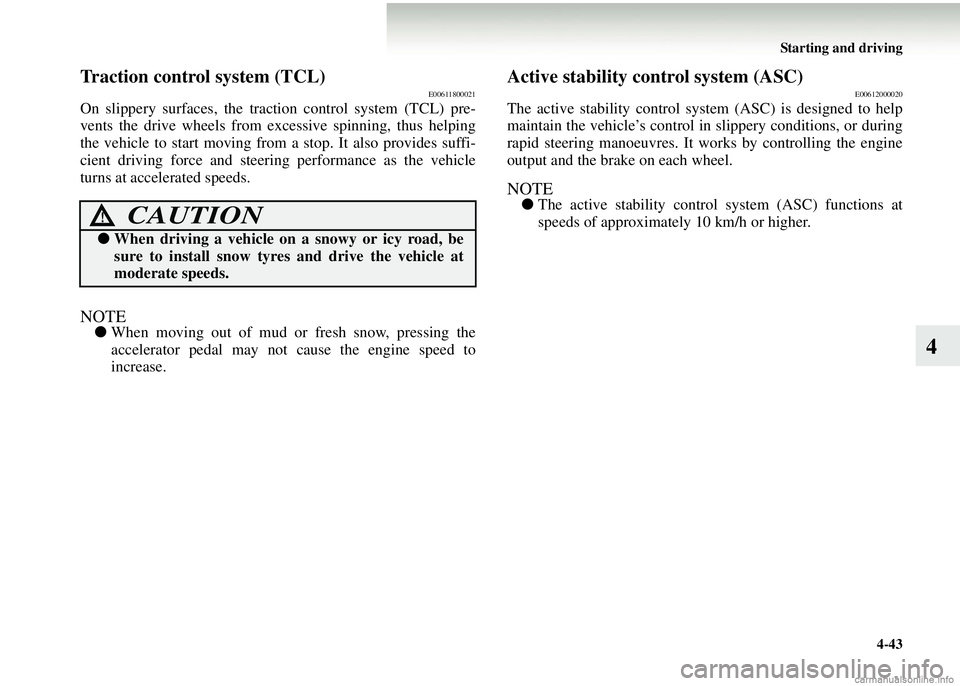
Starting and driving4-43
4
Traction control system (TCL)E00611800021
On slippery surfaces, the traction control system (TCL) pre-
vents the drive wheels from exces sive spinning, thus helping
the vehicle to start m oving from a stop. It also provides suffi-
cient driving force and steerin g performance as the vehicle
turns at accelerated speeds.
NOTE● When moving out of mud or fresh snow, pressing the
accelerator pedal may not cause the engine speed to
increase.
Active stability control system (ASC)E00612000020
The active stability control syst em (ASC) is designed to help
maintain the vehicle’s control in slippery conditions, or during
rapid steering manoeuvres. It works by controlling the engine
output and the brake on each wheel.
NOTE● The active stability control system (ASC) functions at
speeds of approximately 10 km/h or higher.CAUTION!
● When driving a vehicle on a snowy or icy road, be
sure to install snow tyre s and drive the vehicle at
moderate speeds.
Page 211 of 450
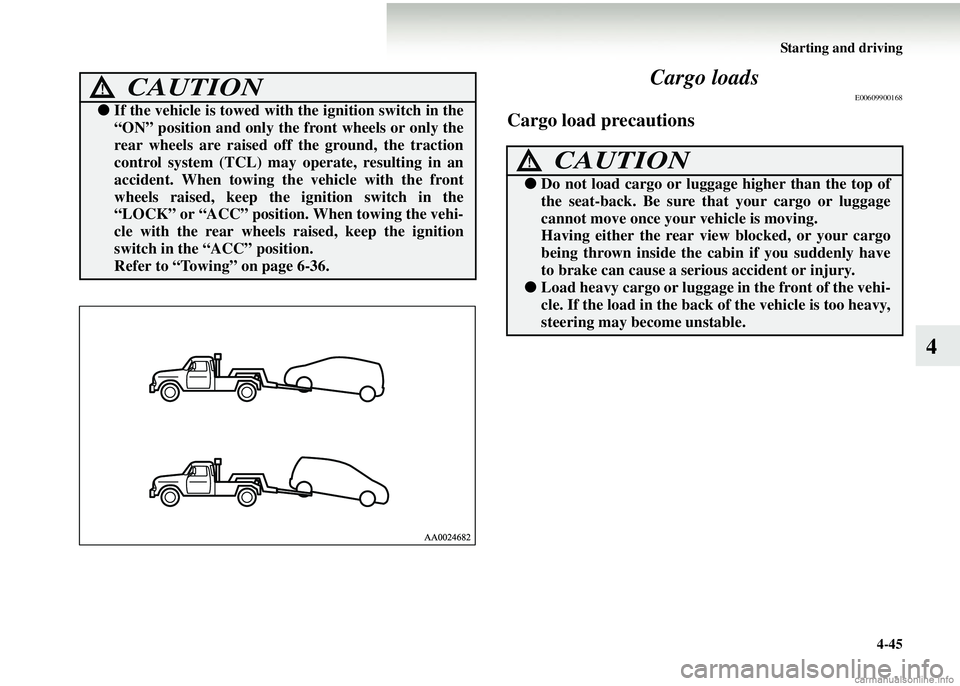
Starting and driving4-45
4
Cargo loads
E00609900168
Cargo load precautions
CAUTION!
●
If the vehicle is towed with the ignition switch in the
“ON” position and only the front wheels or only the
rear wheels are raised off the ground, the traction
control system (TCL) may operate, resulting in an
accident. When towing th e vehicle with the front
wheels raised, keep the ig nition switch in the
“LOCK” or “ACC” position. When towing the vehi-
cle with the rear wheels raised, keep the ignition
switch in the “ACC” position.
Refer to “Towing” on page 6-36.
CAUTION!
● Do not load cargo or luggage higher than the top of
the seat-back. Be sure that your cargo or luggage
cannot move once your vehicle is moving.
Having either the rear view blocked, or your cargo
being thrown inside the cabin if you suddenly have
to brake can cause a serious accident or injury.
●Load heavy cargo or luggage in the front of the vehi-
cle. If the load in the back of the vehicle is too heavy,
steering may become unstable.
Page 217 of 450
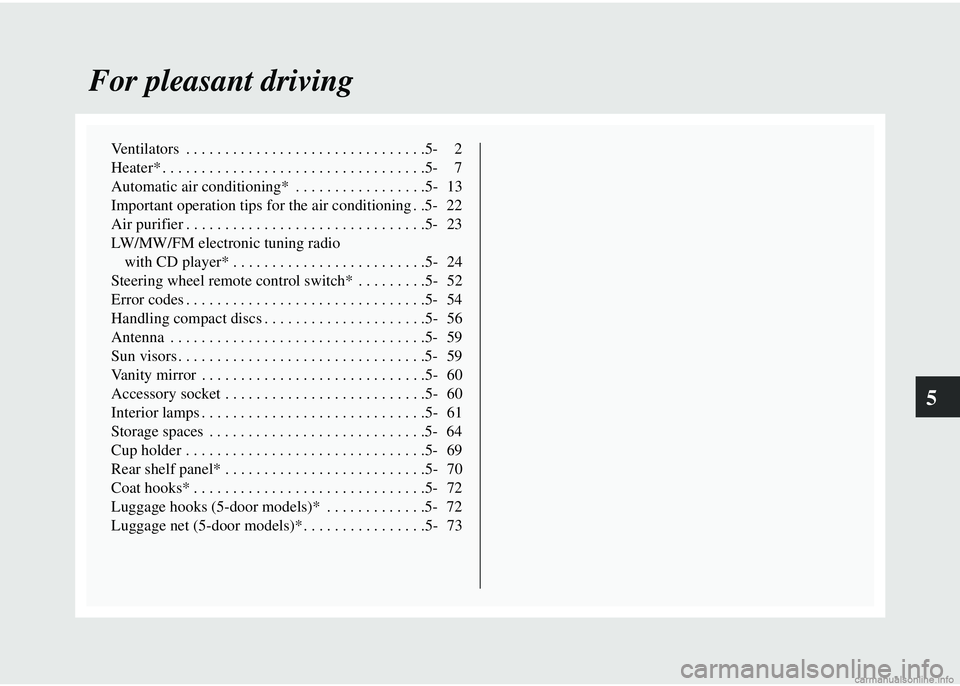
5
For pleasant driving
Ventilators . . . . . . . . . . . . . . . . . . . . . . . . . . . . . . .5- 2
Heater* . . . . . . . . . . . . . . . . . . . . . . . . . . . . . . . . . .5- 7
Automatic air conditioning* . . . . . . . . . . . . . . . . .5- 13
Important operation tips for the air conditioning . .5- 22
Air purifier . . . . . . . . . . . . . . . . . . . . . . . . . . . . . . .5- 23
LW/MW/FM electronic tuning radio with CD player* . . . . . . . . . . . . . . . . . . . . . . . . .5- 24
Steering wheel remote control switch* . . . . . . . . .5- 52
Error codes . . . . . . . . . . . . . . . . . . . . . . . . . . . . . . .5- 54
Handling compact discs . . . . . . . . . . . . . . . . . . . . .5- 56
Antenna . . . . . . . . . . . . . . . . . . . . . . . . . . . . . . . . .5- 59
Sun visors . . . . . . . . . . . . . . . . . . . . . . . . . . . . . . . .5- 59
Vanity mirror . . . . . . . . . . . . . . . . . . . . . . . . . . . . .5- 60
Accessory socket . . . . . . . . . . . . . . . . . . . . . . . . . .5- 60
Interior lamps . . . . . . . . . . . . . . . . . . . . . . . . . . . . .5- 61
Storage spaces . . . . . . . . . . . . . . . . . . . . . . . . . . . .5- 64
Cup holder . . . . . . . . . . . . . . . . . . . . . . . . . . . . . . .5- 69
Rear shelf panel* . . . . . . . . . . . . . . . . . . . . . . . . . .5- 70
Coat hooks* . . . . . . . . . . . . . . . . . . . . . . . . . . . . . .5- 72
Luggage hooks (5-door models)* . . . . . . . . . . . . .5- 72
Luggage net (5-door models)* . . . . . . . . . . . . . . . .5- 73
Page 268 of 450
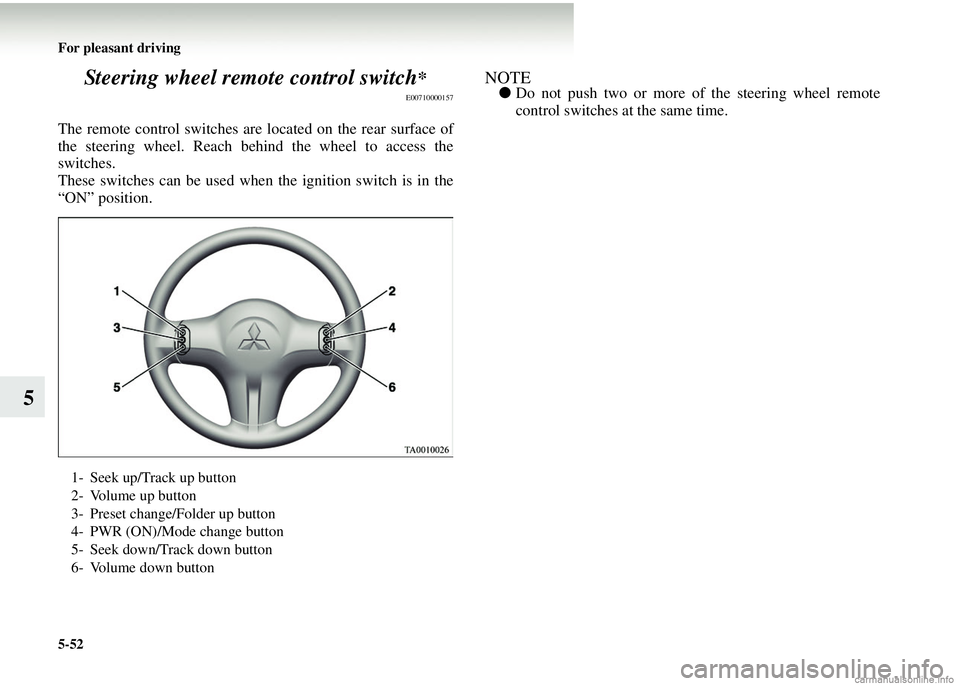
5-52 For pleasant driving
5Steering wheel remote control switch
*
E00710000157
The remote control switches ar
e located on the rear surface of
the steering wheel. Reach be hind the wheel to access the
switches.
These switches can be used when the ignition switch is in the
“ON” position.
NOTE● Do not push two or more of the steering wheel remote
control switches at the same time.
1- Seek up/Track up button
2- Volume up button
3- Preset change/Folder up button
4- PWR (ON)/Mode change button
5- Seek down/Track down button
6- Volume down button
Page 316 of 450
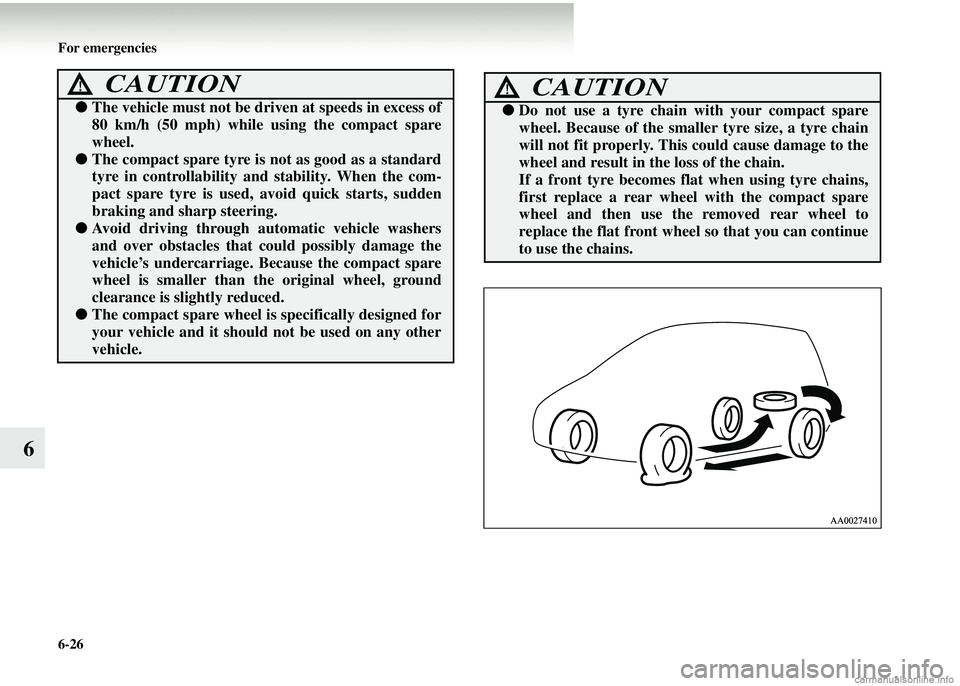
6-26 For emergencies
6
●The vehicle must not be driven at speeds in excess of
80 km/h (50 mph) while using the compact spare
wheel.
● The compact spare tyre is not as good as a standard
tyre in controllability and stability. When the com-
pact spare tyre is used, avoid quick starts, sudden
braking and sharp steering.
●Avoid driving through au tomatic vehicle washers
and over obstacles that could possibly damage the
vehicle’s undercarriage. Because the compact spare
wheel is smaller than th e original wheel, ground
clearance is slightly reduced.
● The compact spare wheel is specifically designed for
your vehicle and it should not be used on any other
vehicle.
CAUTION!CAUTION!
● Do not use a tyre chain with your compact spare
wheel. Because of the small er tyre size, a tyre chain
will not fit properly. This could cause damage to the
wheel and result in the loss of the chain.
If a front tyre becomes flat when using tyre chains,
first replace a rear wheel with the compact spare
wheel and then use the removed rear wheel to
replace the flat front wheel so that you can continue
to use the chains.
Page 324 of 450
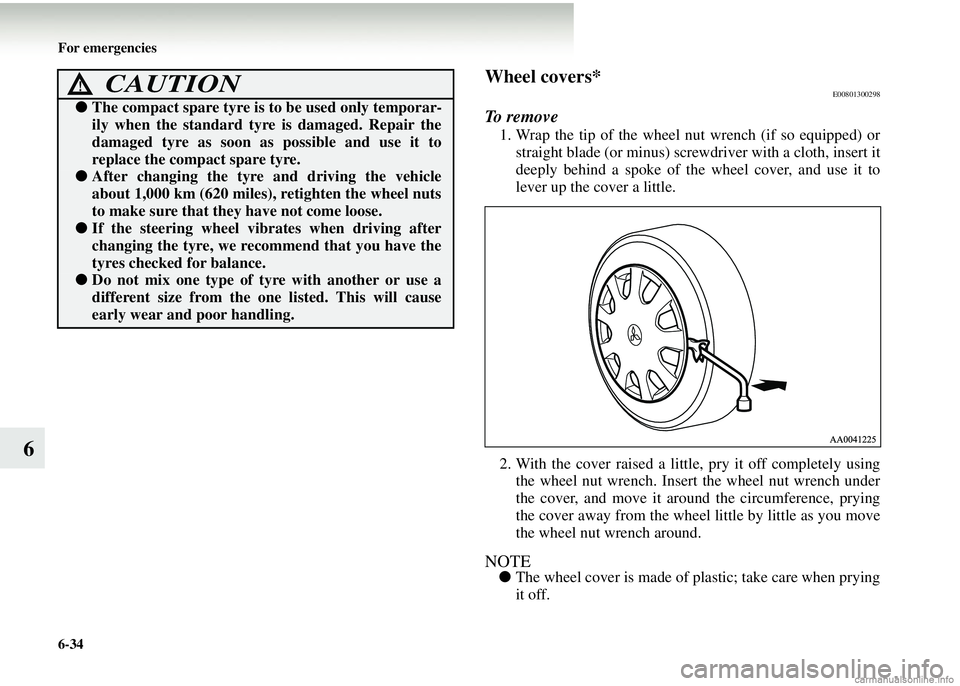
6-34 For emergencies
6
Wheel covers*E00801300298
To remove
1. Wrap the tip of the wheel nut wrench (if so equipped) or
straight blade (or minus) screwdriver with a cloth, insert it
deeply behind a spoke of the wheel cover, and use it to
lever up the cover a little.
2. With the cover raised a little, pry it off completely using the wheel nut wrench. Insert the wheel nut wrench under
the cover, and move it around the circumference, prying
the cover away from the wheel little by little as you move
the wheel nut wrench around.
NOTE● The wheel cover is made of pl astic; take care when prying
it off.
● The compact spare tyre is to be used only temporar-
ily when the standard tyre is damaged. Repair the
damaged tyre as soon as possible and use it to
replace the compact spare tyre.
● After changing the tyre and driving the vehicle
about 1,000 km (620 miles) , retighten the wheel nuts
to make sure that they have not come loose.
● If the steering wheel vibr ates when driving after
changing the tyre, we recommend that you have the
tyres checked for balance.
● Do not mix one type of tyre with another or use a
different size from the one listed. This will cause
early wear and poor handling.
CAUTION!
Page 327 of 450
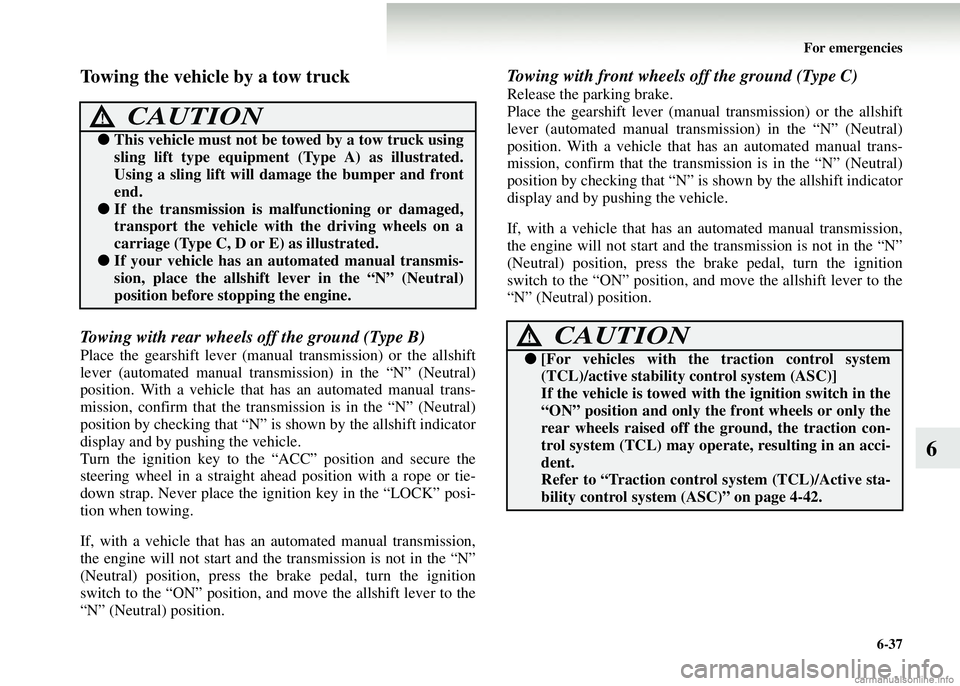
For emergencies6-37
6
Towing the vehicle by a tow truck
Towing with rear wheels off the ground (Type B)
Place the gearshift lever (manual transmission) or the allshift
lever (automated manual transm ission) in the “N” (Neutral)
position. With a vehicle that has an automated manual trans-
mission, confirm that the transm ission is in the “N” (Neutral)
position by checking that “N” is shown by the allshift indicator
display and by pushing the vehicle.
Turn the ignition key to the “ACC” position and secure the
steering wheel in a straight ah ead position with a rope or tie-
down strap. Never place the igni tion key in the “LOCK” posi-
tion when towing.
If, with a vehicle that has an automated manual transmission,
the engine will not start and the transmission is not in the “N”
(Neutral) position, press the brake pedal, turn the ignition
switch to the “ON” position, and move the allshift lever to the
“N” (Neutral) position.
Towing with front wheels off the ground (Type C)
Release the parking brake.
Place the gearshift lever (manual transmission) or the allshift
lever (automated manual transm ission) in the “N” (Neutral)
position. With a vehicle that has an automated manual trans-
mission, confirm that the transmi ssion is in the “N” (Neutral)
position by checking th at “N” is shown by the allshift indicator
display and by pushing the vehicle.
If, with a vehicle that has an automated manual transmission,
the engine will not start and th e transmission is not in the “N”
(Neutral) position, press the brake pedal, turn the ignition
switch to the “ON” position, and move the allshift lever to the
“N” (Neutral) position.
CAUTION!
● This vehicle must not be towed by a tow truck using
sling lift type equipment (Type A) as illustrated.
Using a sling lift will da mage the bumper and front
end.
● If the transmission is malfunctioning or damaged,
transport the vehicle with the driving wheels on a
carriage (Type C, D or E) as illustrated.
●If your vehicle has an automated manual transmis-
sion, place the a llshift lever in the “N” (Neutral)
position before stopping the engine.
CAUTION!
● [For vehicles with the traction control system
(TCL)/active stability control system (ASC)]
If the vehicle is towed with the ignition switch in the
“ON” position and only th e front wheels or only the
rear wheels raised off the ground, the traction con-
trol system (TCL) may operate, resulting in an acci-
dent.
Refer to “Traction control system (TCL)/Active sta-
bility control system (ASC)” on page 4-42.
Page 330 of 450
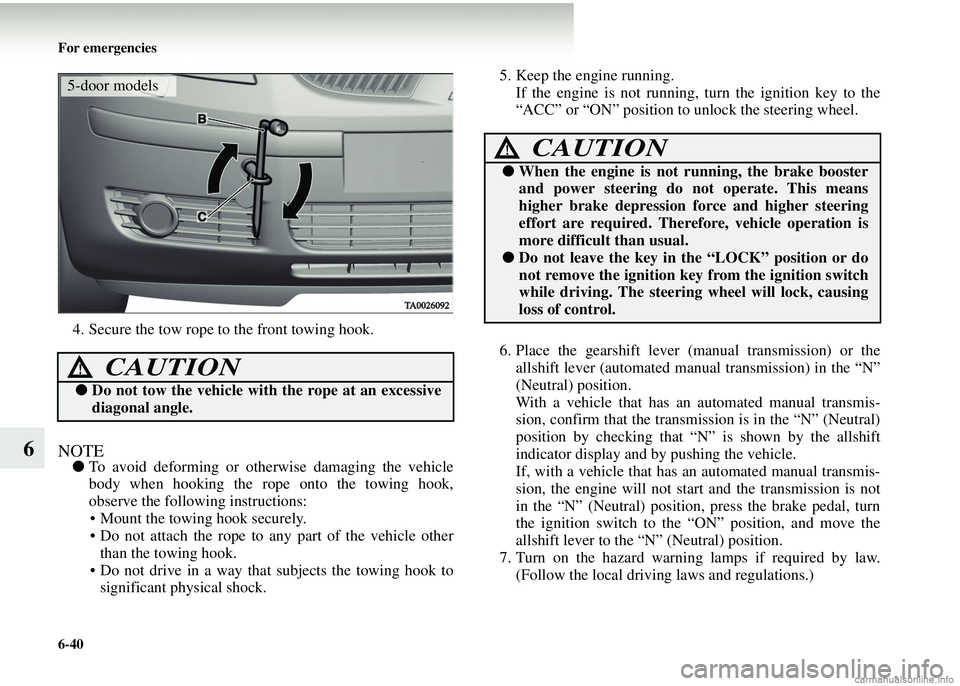
6-40 For emergencies
6
4. Secure the tow rope to the front towing hook.
NOTE●To avoid deforming or otherwise damaging the vehicle
body when hooking the rope onto the towing hook,
observe the following instructions:
• Mount the towing hook securely.
• Do not attach the rope to any part of the vehicle other
than the towing hook.
• Do not drive in a way that subjects the towing hook to significant physical shock. 5. Keep the engine running.
If the engine is not running, turn the ignition key to the
“ACC” or “ON” position to unlock the steering wheel.
6. Place the gearshift lever (m anual transmission) or the
allshift lever (automated manual transmission) in the “N”
(Neutral) position.
With a vehicle that has an automated manual transmis-
sion, confirm that the transmi ssion is in the “N” (Neutral)
position by checking that “N ” is shown by the allshift
indicator display and by pushing the vehicle.
If, with a vehicle that has an automated manual transmis-
sion, the engine will not start and the transmission is not
in the “N” (Neutral) position, press the brake pedal, turn
the ignition switch to the “ON” position, and move the
allshift lever to the “N” (Neutral) position.
7. Turn on the hazard warning lamps if required by law. (Follow the local driving laws and regulations.)
CAUTION!
● Do not tow the vehicle with the rope at an excessive
diagonal angle.
5-door models
CAUTION!
● When the engine is not running, the brake booster
and power steering do no t operate. This means
higher brake depression force and higher steering
effort are required. Therefore, vehicle operation is
more difficult than usual.
● Do not leave the key in the “LOCK” position or do
not remove the ignition key from the ignition switch
while driving. The steering wheel will lock, causing
loss of control.
Page 334 of 450
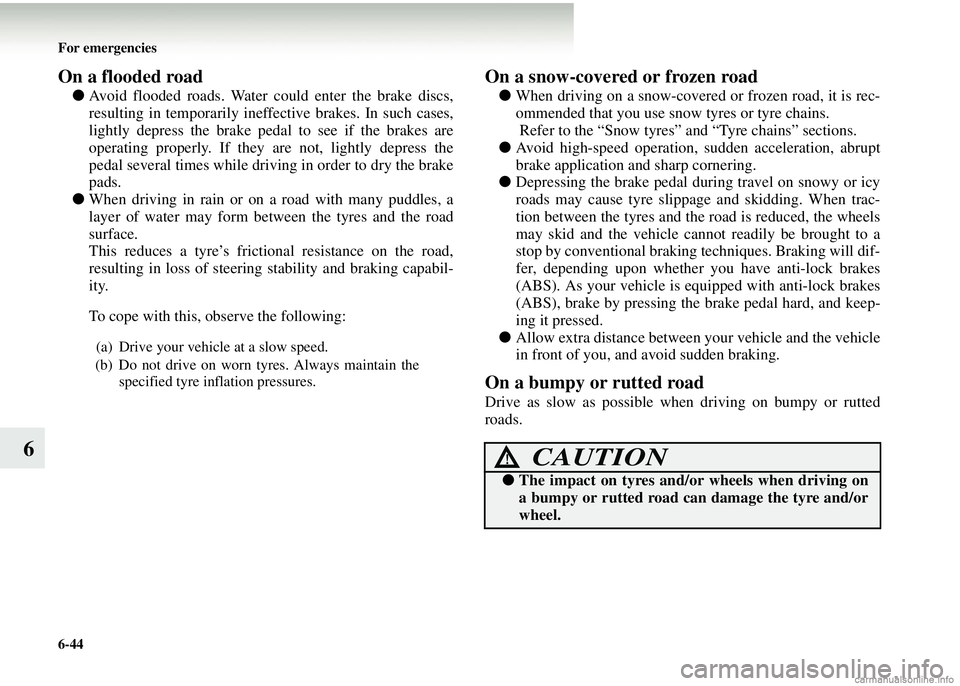
6-44 For emergencies
6
On a flooded road
●Avoid flooded roads. Water could enter the brake discs,
resulting in temporarily ineff ective brakes. In such cases,
lightly depress the brake pedal to see if the brakes are
operating properly. If they are not, lightly depress the
pedal several times while driving in order to dry the brake
pads.
● When driving in rain or on a road with many puddles, a
layer of water may form between the tyres and the road
surface.
This reduces a tyre’s frictional resistance on the road,
resulting in loss of steering stability and braking capabil-
ity.
To cope with this, observe the following:
On a snow-covered or frozen road
●When driving on a snow-covered or frozen road, it is rec-
ommended that you use snow tyres or tyre chains.
Refer to the “Snow tyres” and “Tyre chains” sections.
● Avoid high-speed operation, sudden acceleration, abrupt
brake application and sharp cornering.
● Depressing the brake pedal during travel on snowy or icy
roads may cause tyre slippage and skidding. When trac-
tion between the tyres and the road is reduced, the wheels
may skid and the vehicle cannot readily be brought to a
stop by conventional braking techniques. Braking will dif-
fer, depending upon whether you have anti-lock brakes
(ABS). As your vehicle is equipped with anti-lock brakes
(ABS), brake by pressing th e brake pedal hard, and keep-
ing it pressed.
● Allow extra distance between yo ur vehicle and the vehicle
in front of you, and avoid sudden braking.
On a bumpy or rutted road
Drive as slow as possible when driving on bumpy or rutted
roads.
(a) Drive your vehicle at a slow speed.
(b) Do not drive on worn tyres. Always maintain the specified tyre inflation pressures.
CAUTION!
●The impact on tyres and/ or wheels when driving on
a bumpy or rutted road can damage the tyre and/or
wheel.